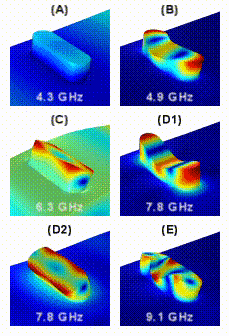
See also Watching ripples on crystals.
Confining sound to a tiny region in solids can be useful for the sensing of adjacent gases or nanoparticles. Sensors already exist for this purpose based on nanoscale gratings that generate and detect surface acoustic waves. But so far no-one has managed to do this using nanostructure lines (1 nm=10-9 m).
In a joint Japan-France collaboration, we demonstrate that this is possible using parallel nanolines.
Our sample is made of glass (see figure below) containing a gold nanowire parallel to a line of gold nanorods, both having a width of only a few tens of nanometers. We generate sound in the nanowire using an ultrashort light pulse.
The sound is converted to surface acoustic waves—waves which skim the surface—that travel toward the gold nanorods and vibrate them. We detect these nanorod vibrations using a second ultrashort light pulse called the probe.

The diagram shows the sample, with the two nanolines separated by a few microns (1 micron=10-6 m). The arrows show the surface acoustic waves. The graph shows the variation in the optical reflectance (proportional to the detected probe light intensity reflected from the nanorods) as the picosecond surface acoustic waves pass the line of nanorods.
We measure the tiny changes in the probe light intensity after its reflection from the line of gold nanorods. The results are shown by the graph. The wiggles on the graph are caused by the vibrations of the nanorods, which we have simulated in the animation below.

Animation showing the different vibrational patterns of a nanorod produced by the surface acoustic waves.
We have also conducted experiments with the nanorods rotated by 90 degrees, which is found to improve the detection sensitivity because of the improved mechanical coupling to the surface acoustic waves.
This research provides an avenue to exquisitely sensitive nanosensing of both inorganic and organic materials, including chemical compounds, adsorbed gases or biological species, over a minimized sensor area between the nanolines.
Full details can be found in
'Gigahertz optomechanical photon-phonon transduction between nanostructure lines,' Y. Imade et al., Nano Lett. 21, 6261 (2021).